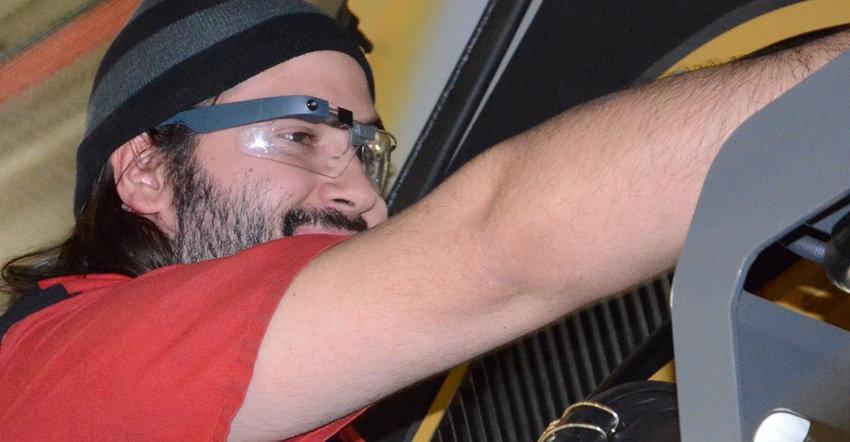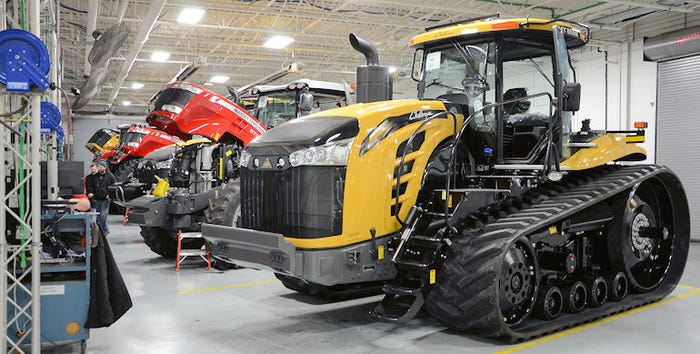April 19, 2017

There's a confluence of technology merging in Jackson, Minn., that might surprise the farmers driving by on Interstate 90. This is the home of high-horsepower tractor manufacturing and high-tech application equipment for Agco with Challenger, Massey Ferguson, RoGator and TerraGator equipment being manufactured at the complex.
This is a complex manufacturing setup. For example, the tractor line could have an MT600 coming down the line in Challenger livery followed by a Massey Ferguson 8700 series machine followed by a Challenger MT800 machine. Over on the application line, a TerraGator could be followed by a RoGator and each could have significantly different setups. It is one of the more unique setups in ag manufacturing.
"And every one of those machines has to be built right," says Rick Reuter, continuous improvement manager, Agco.

Agco's Jackson, Minn., facility is unique based on the number of brands, and machine variations, produced in its facilities. Informed reality technology will help manage production and quality.
Add in that each employee on the line needs to be educated, and remember, specific procedures for machines they don't build all the time, and the plant faced a big challenge. And the easy answer was not the right answer, as Peggy Gulick noted when she showed off a busted tablet computer. "This was where we started with this problem," she says of that cracked tablet. Gulick is director, business process improvement, Agco.
Where to turn? The answer is Informed Reality. Many have heard of virtual reality or augmented reality. In this case, the Jackson, Minn., plant implemented something a little different with the help of a tool that many thought had been abandoned - Google Glass. "It isn't going away," says Gulick. "In fact, they've come up with a new system that we have found works very well."
Line employees building equipment are wearing Google Glass to do their work. If a machine comes into their work area for specific tasks they can query Google to pull up the specs or answer questions about the process at that station. "We have a robust network here in the plant for our data," says Brandon Ross, systems analyst, Agco.
Robust is a nice word for a network that has to work across two buildings in a small town in southwest Minnesota. What Agco has created allows manufacturing employees instant access to the information they need when they need it. During a demonstration of the system, Gulick was able to show how an employee would pull up diagrams or work processes starting with the simple command "Okay Glass..." followed by a specific two-word phrase for that station for that set of instructions.
Wade White, senior manufacturing engineer, explains that having that information is key. "We're working constantly on process and quality improvement here at the facility," he says. "Having that information available at all times, should reduce rework and boost initial quality further."
Not a typical manufacturing setting
Many envision a manufacturing plant as a kind of Charlie Chaplin process where you turn a nut and the machine moves on to the next station. That's not how the Jackson facility is set up. Instead, when a machine moves into a work-station the employee, or employees, at that station have to perform a wide range of tasks.
For example, the hydraulic system installation is a multiple series of steps that is tractor-model specific. And knowing the differences between a Massey Ferguson 8700 versus a Challenger MT800, which may be similar in some ways, is the challenge. Also, those workstation tasks are timed tasks, where along each station the workers know they have a certain amount of time to perform manufacturing tasks.
Tracking monitors in the plant know how fast a work station is moving, and will go from green to yellow to red if a problem develops. These days, manufacturing productivity is critical. Having key information available to those workstations when its needed, simply at an "Okay Glass" command important.

This tracking board can tell observers which parts of the line are working at speed (in green), or potentially falling behind (in yellow). It's just another way technology is applied at the Agco Jackson, Minn., facility.
This tracking board can tell observers which parts of the line are working at speed (in green), or potentially falling behind (in yellow). It's just another way technology is applied at the Agco Jackson, Minn., facility.
Add in that multi-product complexity, and this tech investment makes sense. Then of course there is the time involved in setting up such a system. Gulick explains that moving manuals and other process instructions into the system, working with a third party, was laborious. However, they found that much of their archived work could be used in the new platform.
Essentially workers are wearing the Google Glass appliance. But this is more than snapping the computer to your glasses, the product had to be designed to be safety glasses-ready, which took some time. And then there was the issue with instructions.
Anyone who has used a voice-activated system like Siri on the iPhone or Alexa for Amazon knows that hearing and understanding are two different issues. Now add in the general background noise of a manufacturing environment. It turns out that wasn't as big an issue as Gulick and the rest of the team thought.
"We did find that single-word commands were not enough for the system," she recalls. "When we moved to two-word commands to bring up information it was more accurate. And factory noise wasn't a problem."
One thing in Agco's favor here is that the instruction set is standard. This isn't a situation where multiple commands about a wide range of topics were being asked - like "who won the 1949 World Series?" These are straight manufacturing questions like "Okay Glass, transmission plans" And it would bring up a model list for the user to scroll, for quick selection.
Informed reality
The many kinds of 'reality' you hear about mean different things. For Virtual Reality you're essentially cut off from the real world into that virtual space. Augmented Reality uses tools like Microsoft Hololens - as we showed from Trimble last year - where glasses project images for you to see in your natural space.
What Agco is using is what they call "informed reality." Essentially the Google Glass-using employees have information they need on a screen they can read without leaving their work to check out a tablet or laptop. This allows them to do their work, do it right and avoid quality issues. One reason for doing that is that Informed vs. Augmented reality is to keep employees safe by not impeding the visual field. It acts more like a rearview mirror - it's there when you need it, but not noticed when you don’t.
Agco can lay claim to being the first to be using informed reality in production, and the company is looking to begin pilot tests in more of its facilities both in the U.S. and abroad within the next year. Farmers can check out this tech at use by traveling to Jackson, Minn., and taking the Intivity Center tour. They're conducted daily during the week, learn more at intivitycenter.com.
About the Author(s)
You May Also Like






